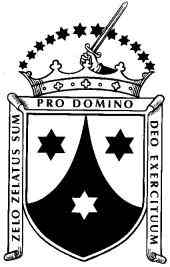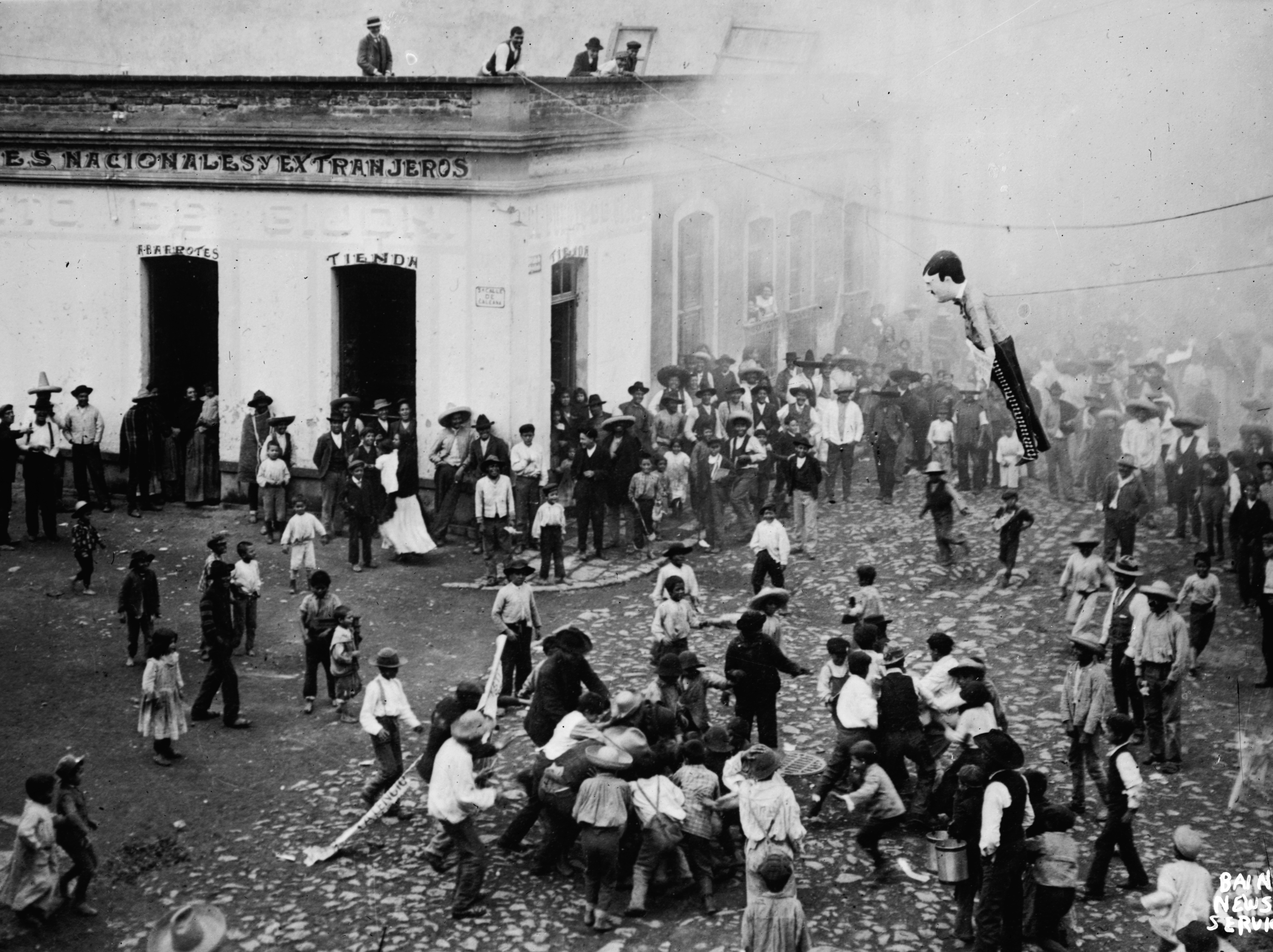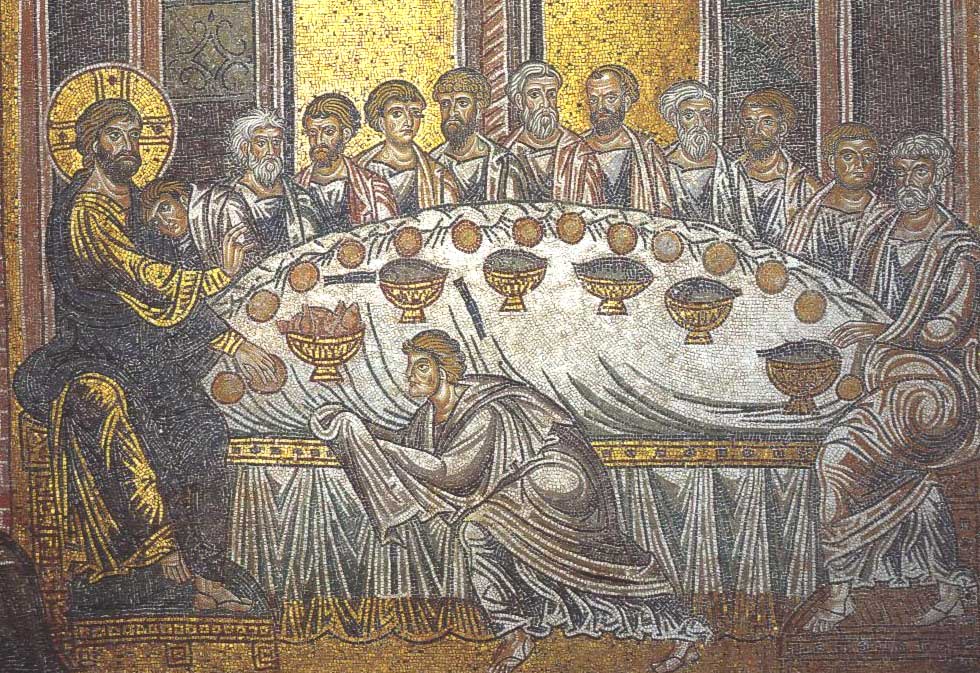|
Procession Of Silence In San Luis Potosi
The Procession of Silence in San Luis Potosi is an annual event to mourn the Passion of Christ and honor Our Lady of Solitude. It occurs on the night of Good Friday, beginning at the El Carmen Church, where it originated, and winds through the streets of the historic center of the city of San Luis Potosí. During the event there are the sounds of drums and bugles, but no participant or spectator speaks, giving the event its name. It is one of the most important Holy Week observances in Mexico and was declared part of the cultural heritage of the state of San Luis Potosí in 2013. Significance Organized by the Tradiciones Potosinas association, the procession commemorates as an act of mourning the Passion of Christ. It is a reenactment of the Stations of the Cross, with each station marked by a heavy platform with the relevant images. This procession is one of the most important Holy Week observances in Mexico, one of the most important religious events for the state of San Lui ... [...More Info...] [...Related Items...] OR: [Wikipedia] [Google] [Baidu] |
Manuel Tolsá
Manuel Vicente Tolsá Sarrión (Enguera, Valencia, Spain, May 4, 1757 – Mexico City, December 24, 1816) was a prolific Neoclassical architect and sculptor in Spain and Mexico. He served as the first director of the Academy of San Carlos. Biography Tolsá studied at the Royal Academy of San Carlos in Valencia and the Royal Academy of San Fernando in Madrid. He was a student of José Puchol in sculpture and of Ribelles, Gascó and Gilabert in architecture. In Spain he was the sculptor of the king's chamber, minister of the Supreme Junta of Commerce, Minting and Mines, and an academic in San Fernando. In 1790 he was named director of sculpture at the recently created Academy of San Carlos in Mexico City. He sailed from Cádiz in February, 1791, bringing with him to New Spain, in accordance with the king's instructions, books, instruments of his profession, and plaster copies of classic sculptures from the Vatican Museum. He married María Luisa de Sanz Téllez Girón y Espinosa ... [...More Info...] [...Related Items...] OR: [Wikipedia] [Google] [Baidu] |
Mexico City
Mexico City ( es, link=no, Ciudad de México, ; abbr.: CDMX; Nahuatl: ''Altepetl Mexico'') is the capital and largest city of Mexico, and the most populous city in North America. One of the world's alpha cities, it is located in the Valley of Mexico within the high Mexican central plateau, at an altitude of . The city has 16 boroughs or ''demarcaciones territoriales'', which are in turn divided into neighborhoods or ''colonias''. The 2020 population for the city proper was 9,209,944, with a land area of . According to the most recent definition agreed upon by the federal and state governments, the population of Greater Mexico City is 21,804,515, which makes it the sixth-largest metropolitan area in the world, the second-largest urban agglomeration in the Western Hemisphere (behind São Paulo, Brazil), and the largest Spanish-speaking city (city proper) in the world. Greater Mexico City has a GDP of $411 billion in 2011, which makes it one of the most productive urb ... [...More Info...] [...Related Items...] OR: [Wikipedia] [Google] [Baidu] |
Carmelites
, image = , caption = Coat of arms of the Carmelites , abbreviation = OCarm , formation = Late 12th century , founder = Early hermits of Mount Carmel , founding_location = Mount Carmel , type = Mendicant order of pontifical right , status = Institute of Consecrated Life , membership = 1,979 (1,294 priests) as of 2017 , leader_title = Motto , leader_name = la, Zelo zelatus sum pro Domino Deo exercituumEnglish: ''With zeal have I been zealous for the Lord God of hosts'' , leader_title2 = General Headquarters , leader_name2 = Curia Generalizia dei CarmelitaniVia Giovanni Lanza, 138, 00184 Roma, Italia , leader_title3 = Prior General , leader_name3 = Mícéal O'Neill, OCarm , leader_title4 = Patron saints , leader_name4 = Our Lady of Mt. Carmel, Elijah , parent_organization = Catholic Church , website = ... [...More Info...] [...Related Items...] OR: [Wikipedia] [Google] [Baidu] |
New Spain
New Spain, officially the Viceroyalty of New Spain ( es, Virreinato de Nueva España, ), or Kingdom of New Spain, was an integral territorial entity of the Spanish Empire, established by Habsburg Spain during the Spanish colonization of the Americas and having its capital in Mexico City. Its jurisdiction comprised a huge area that included what is now Mexico, the Western and Southwestern United States (from California to Louisiana and parts of Wyoming, but also Florida) in North America; Central America, the Caribbean, very northern parts of South America, and several territorial Pacific Ocean archipelagos. After the 1521 Spanish conquest of the Aztec empire, conqueror Hernán Cortés named the territory New Spain, and established the new capital, Mexico City, on the site of the Tenochtitlan, the capital of the Mexica (Aztec) Empire. Central Mexico became the base of expeditions of exploration and conquest, expanding the territory claimed by the Spanish Empire. With the ... [...More Info...] [...Related Items...] OR: [Wikipedia] [Google] [Baidu] |
Venado
Venado is a town and municipality in San Luis Potosí San Luis Potosí (), officially the Free and Sovereign State of San Luis Potosí ( es, Estado Libre y Soberano de San Luis Potosí), is one of the 32 states which compose the Federal Entities of Mexico. It is divided in 58 municipalities and i ... in central Mexico. The name in Spanish means '' deer''. References {{coord, 22.9333, N, 101.093, W, source:kolossus-eswiki, display=title Municipalities of San Luis Potosí ... [...More Info...] [...Related Items...] OR: [Wikipedia] [Google] [Baidu] |
Burning Of Judas
The burning of Judas is an Easter-time ritual that originated in European Christian communities where an effigy of Judas Iscariot is burned. Other related mistreatment of Judas effigies include hanging, flogging, and exploding with fireworks. A similar ritual in Jewish tradition would be the hanging and burning an effigy of Haman and his ten sons during Purim, although this is not a widespread contemporary practice. Though not an official part of the Easter liturgical cycle, the custom is typically a part of the reenactment of the story of the Passion that is practiced by the faithful during Easter. Customs vary, but the effigy of Judas is typically hanged (reenacting ) on Good Friday, then burned on the night of Easter Sunday. In many parts of Latin America this practice occurs on the eve of the New Year as a symbol of ridding one's self of evil and beginning a new year in spiritual purity. Some communities observe this ritual using various effigies, including the biblical Jud ... [...More Info...] [...Related Items...] OR: [Wikipedia] [Google] [Baidu] |
Holy Saturday
Holy Saturday ( la, Sabbatum Sanctum), also known as Great and Holy Saturday (also Holy and Great Saturday), the Great Sabbath, Hallelujah Saturday (in Portugal and Brazil), Saturday of the Glory, Sabado de Gloria, and Black Saturday or Easter Eve, and called "Joyous Saturday", "the Saturday of Light", and "Mega Sabbatun" among Coptic Christians, is the final day of Holy Week, between Good Friday and Easter Sunday, when Christians prepare for the latter. The day commemorates the Harrowing of Hell while Jesus Christ's body lay in the tomb. Christians of the Catholic, Lutheran, Methodist, Anglican and Reformed denominations begin the celebration of the Easter Vigil service on Holy Saturday, which provides a transition to the season of Eastertide; in the Moravian Christian tradition, graves are decorated with flowers during the day of Holy Saturday and the celebration of the sunrise service starts before dawn on Easter Sunday. Terminology Jewish Nazarenes Whereas the Gr ... [...More Info...] [...Related Items...] OR: [Wikipedia] [Google] [Baidu] |
Chamomile
Chamomile (American English) or camomile (British English; see spelling differences) ( or ) is the common name for several plants of the family Asteraceae. Two of the species, '' Matricaria recutita'' and '' Anthemis nobilis'', are commonly used to make herbal infusions for beverages. There is insufficient scientific evidence that consuming chamomile in foods or beverages has any beneficial effects on health. Etymology The word ''chamomile'' is derived via the French and Latin, from the Greek grc, χαμαίμηλον, khamaimēlon, earth apple, label=none, from grc, χαμαί, khamai, on the ground, label=none, and grc, μῆλον, mēlon, apple, label=none. First used in the 13th century, the spelling ''chamomile'' corresponds to the Latin and the Greek . The spelling ''camomile'' is a British derivation from the French. Species Some commonly used species include: * ''Matricaria chamomilla'' – often called "German chamomile" or "Water of Youth" * '' Chamaemelu ... [...More Info...] [...Related Items...] OR: [Wikipedia] [Google] [Baidu] |
Last Supper
Image:The Last Supper - Leonardo Da Vinci - High Resolution 32x16.jpg, 400px, alt=''The Last Supper'' by Leonardo da Vinci - Clickable Image, Depictions of the Last Supper in Christian art have been undertaken by artistic masters for centuries, Leonardo da Vinci's late-1490s mural painting in Milan, Italy, being the best-known example. ''(Clickable image—use cursor to identify.)'' poly 550 2550 750 2400 1150 2300 1150 2150 1200 2075 1500 2125 1525 2300 1350 2800 1450 3000 1700 3300 1300 3475 650 3500 550 3300 450 3000 Bartholomew poly 1575 2300 1625 2150 1900 2150 1925 2500 1875 2600 1800 2750 1600 3250 1425 3100 1400 2800 1375 2600 James Minor poly 1960 2150 2200 2150 2350 2500 2450 2575 2375 2725 2375 2900 2225 3100 2225 3225 1600 3225 1825 2700 1975 2450 1925 2300 Andrew poly 2450 2575 2775 2500 2700 2650 2800 2700 2600 3000 2600 3250 2300 3250 2200 3200 2300 3000 Peter poly 2750 2500 2950 2400 3125 2600 3175 2700 3300 2850 3700 3200 3750 3200 3650 3350 3400 3200 3000 3 ... [...More Info...] [...Related Items...] OR: [Wikipedia] [Google] [Baidu] |
Maundy Thursday
Maundy Thursday or Holy Thursday (also known as Great and Holy Thursday, Holy and Great Thursday, Covenant Thursday, Sheer Thursday, and Thursday of Mysteries, among other names) is the day during Holy Week that commemorates the Washing of the Feet (Maundy) and Last Supper of Jesus Christ with the Apostles, as described in the canonical gospels. It is the fifth day of Holy Week, preceded by Holy Wednesday and followed by Good Friday. "Maundy" comes from the Latin word ''mandatum'', or commandment, reflecting Jesus' words "I give you a new commandment." The day comes always between March 19 and April 22, inclusive, and will vary according to whether the Gregorian calendar or the Julian calendar is used. Eastern churches generally use the Julian system. Maundy Thursday initiates the Paschal Triduum, the period which commemorates the passion, death, and resurrection of Jesus; this period includes Good Friday and Holy Saturday, and ends on the evening of Easter Sunday. The M ... [...More Info...] [...Related Items...] OR: [Wikipedia] [Google] [Baidu] |




